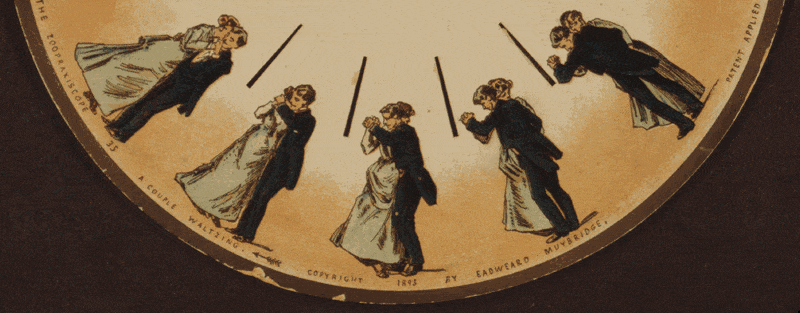GIFs are nothing new, really ” yet the influence they hold in today’s world of social media marketing is. Having emerged in the 90s, animated GIFs have become their own visual medium and hold their own place in digital art and marketing. The repeated never-ending motion of GIFs grabs and holds viewers’ attention in ways that neither video nor photo achieve. Now, with added support on social platforms, GIFs can help brands cut through the clutter of today’s digital landscape.
Phenakistoscopes: The original GIF
Before jumping into how to use GIFs, let’s take a step back in time and look at what’s unique about the medium itself. GIFs represent a return to the earliest examples of motion pictures. The history of the moving image begins with toys like the phenakistoscope, which uses a short series of images placed on a rotating card that animate when spun.
Animated GIFs are the ultimate throwback and work under the same visual constraints as phenakistoscopes. They embody a primitive nature of animation that boils the art down to its most simple and pure form: a series of images that when viewed in succession create the appearance of movement. Who doesn’t love the choppy never-ending series of images which usually depict our favorite or least favorite celebrities at their best… or worst.
Yes, that IS Nicolas Cage’s face motion-tracked onto Miley Cyrus! The internet continues to change lives!
The GIF grows up
While GIFs are generally known as a fun, choppy sequence of images, there’s also been an influx of more sophisticated and well thought out GIFs used in fine art and advertising. These GIFs embrace and perfect the “endless loop” to create animations that seamlessly go on forever. Sam Cannon is a great example of a GIF maker who pushes the boundaries of the medium by creating compelling, fine art. Her work embodies the space between photo and video by creating complex and surreal GIFs that engage and perplex.
(Credit: @samcannon – instagram)
The intoxicating quality of a well done GIF has a way of grabbing and holding a viewer’s attention differently than still images or standard video. They engage and challenge the viewer to “figure it out.” Is this a photo or video? Where is the loop? What’s the beginning and end? Am I dreaming? What’s my purpose in life…? Well maybe not THAT deep, but you get the point.
Cinemagraph-tastic
A cinemagraph is a GIF or video where much of the image appears to be a traditional still photo, while a specific part of the image is shown as motion. The first (well known) cinemagraph was created by Coca Cola and featured the red Coke can sitting next to a swimming pool with moving water. Since then, people have pushed this concept to make compelling attention grabbing advertising images. Cinemagraphs lend themselves well to advertising because they provide room for messaging in a way that many GIFs and videos don’t. While motion grabs attention, it can also clutter an image. With cinemagraphs, marketers can use motion to grab attention without taking away from the messaging of the ad itself.
(Cinemagraphs created by AIMCLEAR for the Zenith Digital Marketing Conference here in Duluth, Minn.)
Using GIFs & cinemagraphs on Facebook and Twitter
There are endless resources for making GIFs ” if you’d like to learn the basic process, here’s a great place to start: http://bit.ly/GIF-how-to. We’ll focus on how to use GIFs as advertising tools in social media channels. Digital marketers are familiar with the many issues when posting an image or video for advertising to Facebook (e.g. the f***ing 20 percent rule!). Twitter has a much more simple process since it natively supports and accepts GIFs and has mostly the same rules as posting images. Basically to get your GIFs in motion on Twitter, the only rules are: one GIF at a time, and 3mb size limit. Facebook, however, supports GIFs, but is really picky and doesn’t give a whole lot of information on what they do and do not support. The result is a lot of trial, error (hair pulling and cussing…), but the end result is eye-catching, brain-melting, engaging, creative. Here are the technical aspects to keep in mind:
- Link to GIFs, no uploading GIFs – Facebook will not natively recognize a GIF, but will recognize a link to a GIF. So the GIF must be hosted on your own website or image hosting sites like Imgur or Giphy. It’s suggested in a marketing setting that you use your own website or a customizable service like WordPress. Seeing Giphy or Imgur in your URL does not come off as professional. The link must also be to the GIF itself, not a page that the GIF is hosted on. This means the URL should end in “.gif”. Just like a video, you can paste the GIF’s URL straight into a Facebook status and it will automatically recognize and display.
- Less than 8 mb – The max file size Facebook currently will play back GIFs at is 7.9 mb. If the image is larger, Facebook will either post a link or a poorly cropped still of the GIF. When trying to reduce file size, start with the image dimensions and then frame-rate rather than reducing colors and quality.
- 470 x 470 pixels – While GIFs with larger dimensions are recognized by Facebook, the largest they will be displayed is 470 x 470. This is because GIFs won’t expand to 1200 pixels wide like still images. Instead, clicking on GIFs in a timeline will result in stopping or starting the GIF animation. This is a good thing to keep in mind when reducing file size.
- Ad rules – The same ad rules that apply to images also apply to GIFs, so keep an eye on that text size (20 percent of the image) as well as other content guidelines.
- Ghosts in the machine – Technical guides for file size, image dimensions and linking are set rules for GIFs on Facebook, but there are still some kinks in the system. Facebook also seems to have an issue with GIF file names. There isn’t a set rule, but in general avoid including technical data like size, fps, or dates as they can confuse Facebook’s recognition of the file as a GIF.
- Patience – Facebook’s GIF recognition isn’t instant. Sometimes it takes up to five minutes for Facebook to link to a file as a GIF. If Facebook isn’t recognizing a GIF, delete the URL, give it a little bit of time and re-paste the URL again.
- Change – As always, Facebook is constantly changing things and adding features. Hopefully some of the limitations on GIFs change or are ” at the very least ” better explained so that a best practices guideline is easier to follow. Until then, as a general rule, start by reducing your file size and changing the document name and go on advertising from there.
You may have considered GIFs useless since you stopped using your MySpace account, but they’re still powerful tools in modern marketing. They digitally encapsulate the excitement and discovery of the earliest motion imaging. They’re fun, accessible and play well with branding. With good planning and execution, GIFs can make your messages stand out in the competitive visual real estate of social marketing and beyond.
















